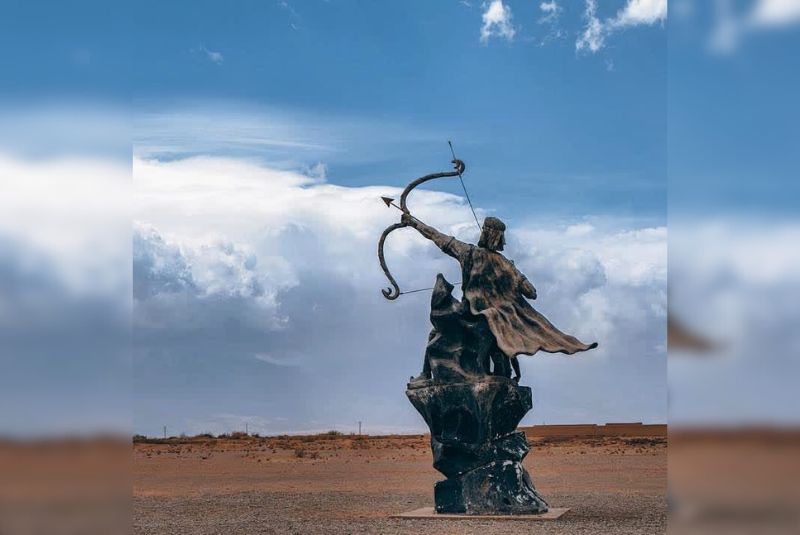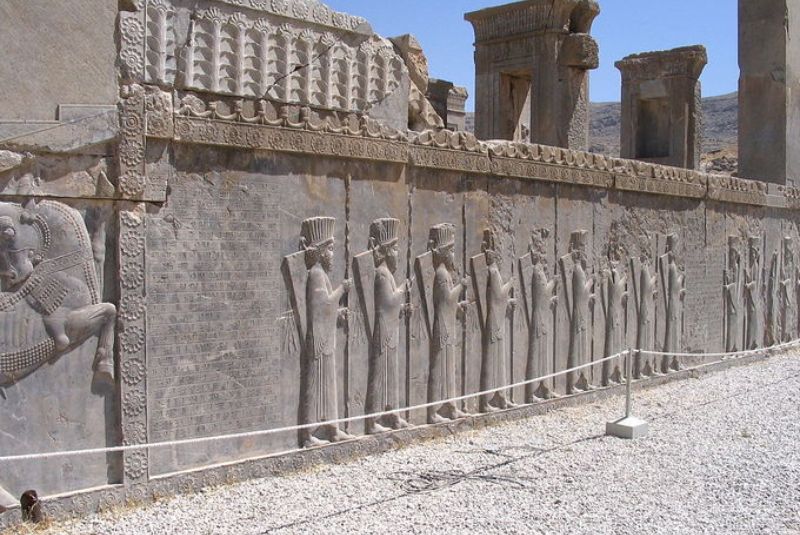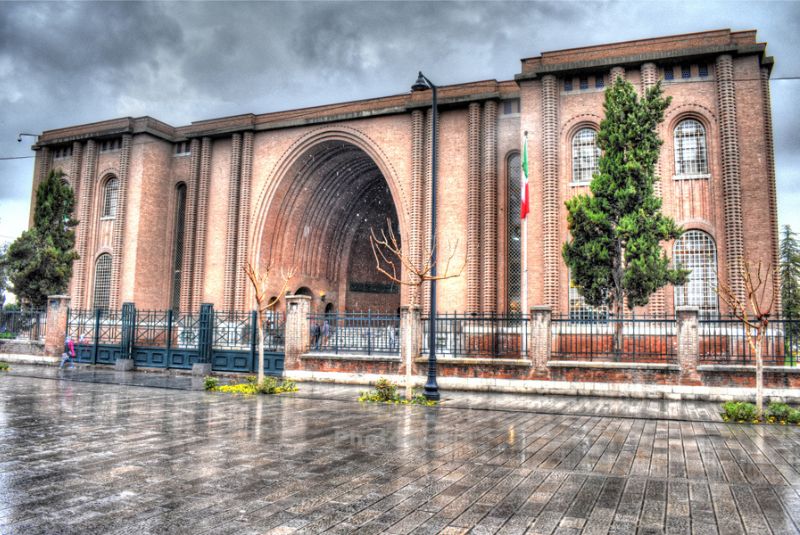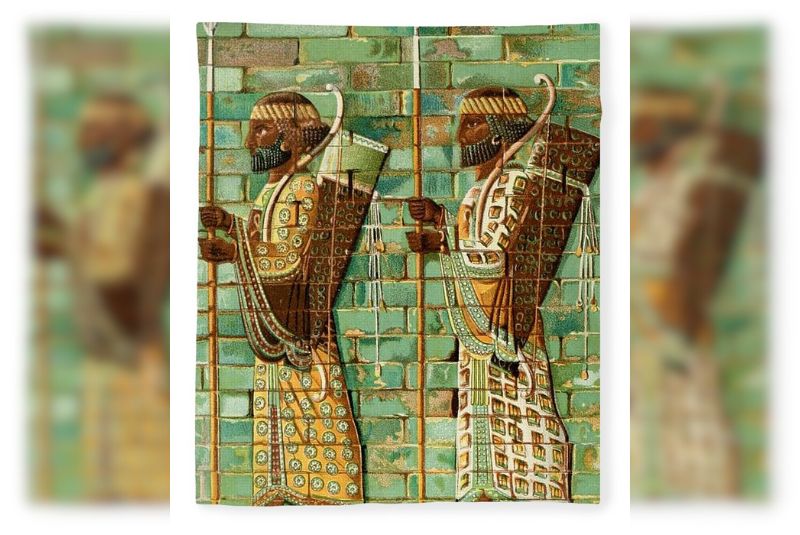Frieze of Archers: The Ancient Persian Power
In the heart of ancient Persia, etched upon the crumbling walls of Persepolis, a silent parade of warriors’ marches.
Frozen in stone, they are the Frieze of Archers - a captivating glimpse into the Achaemenid Empire's might and cultural tapestry. More than just soldiers, these figures whisper stories of strategic brilliance, diverse unity, and the echoes of a bygone era. Step closer, and let the frieze unveil its secrets, one intricate carving at a time.
Ancient Persia: Overview of the Achaemenid Empire

The Achaemenid Empire, one of the ancient world's most formidable civilizations, emerged under the leadership of Cyrus the Great around 550 BCE. Under his reign, the empire expanded significantly, encompassing vast territories across Asia, Africa, and Europe. Notable conquests included the absorption of the Neo-Babylonian Empire and the incorporation of regions from Egypt to the Indus Valley.
Successive Achaemenid rulers, particularly Darius and Xerxes, continued to strengthen and administer the empire. Their reigns witnessed administrative innovations, such as the establishment of a standardized currency and a sophisticated postal system known as the "Royal Road." Culturally, the empire thrived, promoting diversity and allowing different regions to maintain their customs and traditions under Persian rule.
Role of Archery in Persian Culture

Archery held a pivotal role in Persian military culture. Trained archers were an essential component of the Persian army, contributing significantly to its effectiveness in battles. Persian archers were renowned for their precision, agility, and strategic importance on the battlefield. Archery was not only a practical skill but also held symbolic significance in Persian society, often depicted in art and celebrated in literature as a mark of valor and skill.
The Persian military honed archery techniques, employing composite bows made from a combination of wood, horn, and sinew, which provided superior range and power compared to other contemporary bows. This emphasis on technological advancement in archery equipment contributed to the success of the Persian armed forces.
| Discover: Sassanid Empire - Rise and Fall of the Sasanians
Purpose of the Frieze of Archers in Persian Architecture

Persian architecture during the Achaemenid period was characterized by grandeur and innovation. Buildings and structures were adorned with intricate designs and artistic elements. The Frieze of Archers, a notable artistic representation, found its place in Persian architectural marvels.
This decorative frieze, depicting rows of archers in elaborate detail, was commonly integrated into the facades of palaces or royal edifices. Positioned in strategic locations, these friezes not only served an ornamental purpose but also conveyed messages of power, military prowess, and the valor of the Persian army. The placement of archer friezes in these architectural contexts underscored the significance of archery in Persian culture and commemorated the empire's martial achievements.
| Suggestion: Bisotun - Rock Relief and Inscription of the Achaemenids
Location and Architectural Significance

The Frieze of Archers, with its original placement on the facades or within the inner chambers of palaces and ceremonial edifices across the Achaemenid Empire, held paramount significance in the architectural landscape. These reliefs adorned the most esteemed buildings, strategically positioned to emphasize their significance and symbolic importance.
The placement of these friezes at eye level or within prominent areas of these structures ensured their visibility to those entering or passing by, allowing for maximum impact and representation of the military prowess and cultural heritage of the Achaemenid rulership.
The specific locations of these friezes varied, but they were often integrated into the grand architectural designs of palaces such as Persepolis, located approximately 60 kilometers northeast of the city of Shiraz in Iran, and Susa, situated in the Khuzestan province of Iran, serving not only as decorative elements but also as visual testaments to the power and authority of the empire.
| Read more: Pasargadae - Legacy of Cyrus the Great & Ancient City
Composition and Design of the Frieze
The Frieze of Archers features meticulously carved and detailed relief sculptures depicting two parallel lines of soldier-archers. Each archer prominently displays a spear, firmly held in both hands, while also carrying a bow and quiver slung over their shoulders. The archers, characterized by their distinct bearded faces and adorned with diadems, are dressed in the traditional long Persian robes, and the notable Persian headdress, the soft felt cap known as the kyrbasia, exemplifying the typical attire of Achaemenid soldiers.
Their footwear comprises laced ankle boots, reflecting the practicality and functionality required for soldiers in the Achaemenid military. The meticulous attention to detail in the rendering of their attire and equipment demonstrates the skillful craftsmanship of the artisans responsible for these reliefs.
Interpretation of the Depicted Archers
The symmetrical arrangement of soldier-archers wielding both spears and bows suggests a dual representation of their prowess in both close combat and ranged warfare. The soldiers' bearded faces and distinct Persian attire further emphasize their cultural and ethnic identity within the empire.
Their depiction in uniform attire and identical poses signifies the disciplined and cohesive nature of the Persian army, highlighting the unity and strength derived from a diverse yet unified force under the Achaemenid rulership. Additionally, the inclusion of diadems may suggest the nobility or elevated status of these depicted soldiers within the military hierarchy.
| Discover: Naqsh-e Rustam - Tomb of the Persian Kings
Symbolism and Meaning
The uniformity and precision in the portrayal of these soldiers symbolize the disciplined unity and cohesion among the diverse peoples within the Achaemenid Empire. It reflects the empire's ability to harness and amalgamate different cultures under a centralized authority, showcasing a collective strength and identity under Persian rulership.
Moreover, the meticulous attention to detail in the soldiers' attire and equipment reflects the empire's emphasis on precision, discipline, and technological advancements in weaponry, emphasizing their prowess in warfare. This portrayal aims to glorify the martial capabilities of the Persian military and the power wielded by the Achaemenid rulers.
In Persian belief systems, certain deities were associated with war, protection, and bravery. The presence of soldiers depicted in a ceremonial or religious architectural context could signify a reverence for these divine aspects, seeking their blessings for military endeavors or safeguarding the empire.
Additionally, some interpretations propose that the symmetrical arrangement of soldiers could represent cosmic order or harmony, reflecting the Persian philosophical concept of asha or cosmic truth, showcasing order and balance within the empire.
Where You Can Find the Frieze of Archers?

Unfortunately, the original Frieze of Archers is not currently located within Iran. While it was originally installed on the walls of King Darius the Great's palace in Susa, located in modern-day southwestern Iran, most of the frieze was excavated in the late 19th century and later dispersed among various museums around the world.
Here's where you can find fragments of the frieze:
- Louvre Museum, Paris: The largest collection of fragments resides here, showcasing several individual archers and scenes from the procession.
- National Museum of Iran, Tehran: A smaller selection of fragments is on display in the museum's archaeological collection.
- British Museum, London: Several individual archers and a depiction of a chariot are exhibited in the museum's galleries.
- Pergamon Museum, Berlin: A single archer fragment is housed in the museum's Near Eastern collection.

Bottom Line
The Frieze of Archers' legacy extends far beyond its historical context. It remains a potent symbol of Persian heritage and cultural identity, inspiring contemporary art and design. Its enduring influence underscores the importance of preserving and studying this masterpiece for future generations, allowing them to connect with the rich history and artistic traditions of ancient Persia.
Share your story!
Comment below and let us know about your Experience.
Your story inspires others!


Comment
Leave a Comment